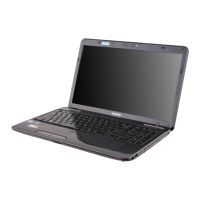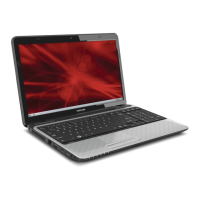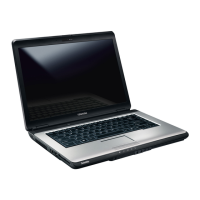
Do you have a question about the Toshiba Satellite L10W-B and is the answer not in the manual?
| RAM | 2 GB DDR3L |
|---|---|
| Storage | 500 GB HDD |
| Graphics | Intel HD Graphics |
| Operating System | Windows 8.1 |
| Weight | 1.3 kg |
| Processor | Intel Celeron N2840 |
| Display | 11.6" 1366x768 Touchscreen |
| Wireless | 802.11b/g/n |
| Ports | 1 x USB 3.0, 1 x USB 2.0, HDMI, Audio combo jack |
Information about copyright, disclaimers, and trademarks for TOSHIBA computers.
Details about FCC compliance and information for Class B digital devices.
Notice regarding AVC, VC-1, and MPEG-4 video patent licensing.
Information about ENERGY STAR compliance and energy efficiency.
Instructions for disposing of the computer and its batteries.
General safety precautions for using TOSHIBA computers.
Guidelines for ensuring proper ventilation for the computer and AC adaptor.
Advice on creating a suitable environment for optimal computer operation.
Information on preventing stress injuries related to computer use.
Precautions regarding heat exposure and potential injuries from prolonged contact.
Warnings against applying excessive pressure or impact to the computer.
Guidelines for safely cleaning the computer and its components.
Precautions to take when moving the computer to ensure safe operation.
Awareness of potential interference from mobile phones.
Reference to the separate manual for safety and comfort information.
Explanation of safety icons used in the manual.
Checklist of hardware and documentation included with the computer.
Explanation of formats and terms used in the manual.
Defines the short names used for TOSHIBA computer models.
Basic information and steps for starting to use the computer.
Instructions on how to open the display panel for specific models.
Instructions on opening the display for convertible models.
Steps for connecting the AC adaptor to power the computer.
Procedure for turning on the computer for the first time.
Steps for the initial setup and Windows installation.
Introduction to Windows operating system features and navigation.
Explanation of the Windows Start screen and its functionalities.
Description of the Windows Taskbar and its features.
How to access power options from the Start screen.
Explanation of Windows Charms and their functions.
Information about tiles on the Windows Start screen.
How to access and use the Windows Store for applications.
Overview of Windows sign-in methods like Password and PIN.
Steps and precautions for shutting down the computer.
Steps and precautions for shutting down the computer.
Methods for restarting the computer.
Explanation of Sleep Mode and its benefits.
Conditions under which Sleep Mode might not function.
Explanation of Hibernation Mode and its data saving.
Advantages of using Hibernation Mode.
Steps to enter Hibernation Mode.
How to configure automatic Hibernation Mode.
How data is saved during Hibernation Mode.
Defines the short names used for TOSHIBA computer models.
Identifies components of the CL10-B/L10-B model.
Shows the front of the CL10-B/L10-B model with the display closed.
Identifies components on the left side of the CL10-B/L10-B model.
Identifies components on the right side of the CL10-B/L10-B model.
Shows the back of the CL10-B/L10-B model.
Shows the underside of the CL10-B/L10-B model.
Shows the CL10-B/L10-B model with the display panel open.
Details about the built-in microphone.
Information about the Web Camera LED indicator.
Details about the Web Camera functionality.
Information about Wireless LAN and Bluetooth antennas.
Specifications and behavior of the LCD display screen.
Function of the Windows button.
Information about the display hinges.
Overview of the computer's keyboard and its keys.
How to use the Touch Pad for pointer control.
Identifies components of the CL10W-B/L10W-B model.
Shows the front of the convertible model with the display closed.
Identifies components on the left side of the convertible model.
Identifies components on the right side of the convertible model.
Shows the back of the convertible model.
Shows the underside of the convertible model.
Shows the convertible model with the display panel open.
Information about the location of magnets and potential interference.
Describes the internal hardware components of your computer.
Information about the internal battery pack.
Information about the computer's processor.
Details about the computer's internal storage capacity.
Information about Video RAM and its usage.
Information about the memory module.
Details about the Graphics Processing Unit performance.
Feature to optimize power consumption by adjusting display contrast.
Explains how power conditions affect computer operation and battery status.
Explains how power conditions affect computer operation and battery status.
Explanation of the Power indicator lights and their meanings.
Instructions for operating the computer in tablet mode.
How to change screen orientation in different modes.
Guide to using the touch screen gestures like tap, pinch, and rotate.
Explanation of touch pad gestures like tap and two-finger tap.
Overview of the computer's keyboard and its keys.
Explanation of keyboard indicators like CAPS LOCK.
Information about the CAPS LOCK indicator light.
Details on function keys (F1-F12) and their modes.
Explanation of special Windows keys like the logo and application keys.
Information and procedures related to the computer's battery.
Information about the lithium-ion battery pack.
How the RTC function is maintained by the battery.
Safety precautions for handling and using the battery pack.
Steps and time required to charge the computer's batteries.
Notices regarding battery charging under specific conditions.
Methods to monitor the remaining battery capacity.
Tips to maximize battery operating time.
Approximate time before batteries exhaust in different modes.
Steps to extend the overall life of battery packs.
Information and procedures for connecting to a Local Area Network.
Information on different types of LAN cables and their compatibility.
Steps for connecting the computer to a LAN.
Information about the memory media slot and types of media.
Important notes about SD/SDHC/SDXC memory cards.
Information on memory media formatting standards.
Instructions for formatting memory media cards.
Precautions for handling and caring for memory media cards.
Explanation of the write-protect function on memory media cards.
Steps for inserting memory media into the slot.
Steps for safely removing memory media from the computer.
Information and procedures for connecting external displays.
How to connect external displays to enhance computer capabilities.
Connecting an external analog monitor using the RGB port.
Connecting external displays via the HDMI port.
Configuring settings for viewing video on HDMI displays.
Steps to select the display mode for HD format.
How to manually manage and change display settings.
Information and procedures for using a security lock.
Steps for connecting a security cable to the lock slot.
List of available optional accessories for the computer.
Information and procedures for audio control functions.
Utility to control audio volume for devices and applications.
How to adjust the microphone recording level.
Applying sound effects for the computer's speakers.
Information about DTS Sound technology and its features.
How to configure video mode settings via Screen Resolution.
Describes pre-installed utilities and how to start them.
Utility for adjusting text size and screen splitting.
Utility to set passwords for restricting computer access.
Customizes hardware settings and peripherals.
BIOS setup utility for viewing and changing BIOS settings.
Utility for managing power consumption and battery life.
Utility to set up special function keys.
Application for searching TOSHIBA software updates and alerts.
Monitors system functions like power, battery, and cooling.
Advanced features that make the computer more convenient to use.
Feature that cuts power to the display when inactive.
Automatically powers off the hard disk drive when not accessed.
Automatically puts the system into Sleep or Hibernation Mode.
Security levels for password protection on startup.
Manages battery charge and protects components from abnormal conditions.
Configures the computer to save battery power.
Automatically turns power off/on when the display panel is closed/opened.
Automatically enters Hibernation Mode when battery is low.
Allows turning off power without exiting software, maintaining data.
Turns off power without exiting software, saving memory to storage.
Restores computer from Sleep Mode based on USB device connection.
How heat dispersal protects the processor from overheating.
Setting up and managing user passwords.
Button to register a password.
Button to delete a registered password.
Button to change a registered password.
Text box to associate text with a password.
Setting up and managing supervisor passwords.
How to start the computer when a user password is registered.
Configuration management tool for hardware and peripherals.
How to navigate the Setup Utility using touch screen and buttons.
Procedures for system recovery and media creation.
Steps to create recovery media for system restoration.
How to restore the computer using created recovery media.
How to restore software from the hidden recovery partition.
Guidelines for effectively resolving computer problems.
Basic checks and simple solutions for common issues.
Questions to consider when analyzing computer malfunctions.
Troubleshooting software-related problems.
Troubleshooting hardware setup and configuration.
Actions to take when the computer experiences issues.
Steps to take when the computer is unresponsive to keyboard input.
How to close programs that have stopped responding.
Checks to perform if the computer fails to start.
Troubleshooting when advanced startup options are not loading.
Checklist for hardware and system component problems.
Troubleshooting power-related issues.
What to do if the computer shuts down due to overheating.
Troubleshooting AC power connection issues.
Troubleshooting common battery problems.
Resolving issues with BIOS settings and system date/time.
Troubleshooting keyboard issues.
Troubleshooting issues with the internal display panel.
Troubleshooting problems with booting from internal storage.
Troubleshooting memory media card errors.
Troubleshooting issues with pointing devices.
Troubleshooting Touch Pad not working or sensitivity issues.
Troubleshooting USB mouse response and double-clicking issues.
Troubleshooting USB device connection and driver issues.
Troubleshooting no sound or annoying sound issues.
Troubleshooting external monitor connection and display issues.
Troubleshooting LAN connection problems.
Troubleshooting wireless LAN connectivity issues.
Troubleshooting Bluetooth device connection issues.
Information and advice for obtaining technical support.
Advice on what to do before contacting TOSHIBA support.
Information on how to get technical support from TOSHIBA.
Summarizes the technical specifications of the computer.
Details the physical dimensions of the computer.
Specifies operating and non-operating environmental conditions.
Details AC adaptor and computer power requirements.
Pin assignment details for the external RGB monitor port.
Specifications for AC power cords and plug compatibility.
Lists certification agencies for power cords in various regions.
Information regarding wireless devices and their interoperability.
Information on Wireless LAN and Bluetooth interoperability.
Discusses health aspects related to wireless device emissions.
Details on Wireless LAN technology and its functions.
Recommendations for enabling wireless security features.
Specifications for wireless LAN cards.
Characteristics of the Wireless LAN module.
Requirements regarding radio frequency interference.
Information on Bluetooth wireless communication technology.
Advanced security mechanisms for Bluetooth.
Information on Bluetooth worldwide operation.
How to establish links between devices.
Information on radio frequency regulations by region.
Use restrictions for 2.4GHz frequencies in Europe.
Use restrictions for 5.15-5.35GHz frequencies in Europe.
Use restrictions for 5.470-5.725GHz frequencies in Europe.
Compliance with Industry Canada rules for this device.
FCC compliance information for Class B digital devices.
Regulations regarding radio frequency devices in Taiwan.
Guidelines for using the equipment in Japan.
Important notice about frequency bandwidth usage in Japan.
Shows indications for Wireless LAN functionality.
Shows indications for Bluetooth functionality.
Information about JEITA standards for wireless LAN.
Details device authorization and technical regulation conformity.
Radio approvals for wireless devices by country/region.
Notes and clarifications on various legal and technical aspects.
Explains icons or switches not present on all models.
Legal footnotes regarding CPU performance.
Compatibility issues with 64-bit systems.
Legal footnotes regarding memory usage and limitations.
Legal footnotes regarding battery life variations.
Explanation of internal storage capacity reporting.
Information on LCD screen brightness deterioration over time.
Legal footnotes regarding GPU performance variations.
Legal footnotes regarding wireless LAN transmission speed.
Information on copy protection standards for media.
VCCI Class B information for Japan.
Details about the OpenSSL toolkit license terms.
Details about the OpenSSL toolkit license terms.
The OpenSSL License text and conditions.
The license terms for The FreeType Project.
The license terms for The FreeType Project.
Alphabetical listing of topics and their page numbers.
Index entries starting with 'A'.
Index entries starting with 'B'.
Index entries starting with 'C'.
Index entries starting with 'D'.
Index entries starting with 'E'.
Index entries starting with 'G'.
Index entries starting with 'H'.
Index entries starting with 'K'.
Index entries starting with 'L'.
Index entries starting with 'M'.
Index entries starting with 'P'.
Index entries starting with 'R'.
Index entries starting with 'S'.
Index entries starting with 'T'.
Index entries starting with 'U'.
Index entries starting with 'V'.
Index entries starting with 'W'.










